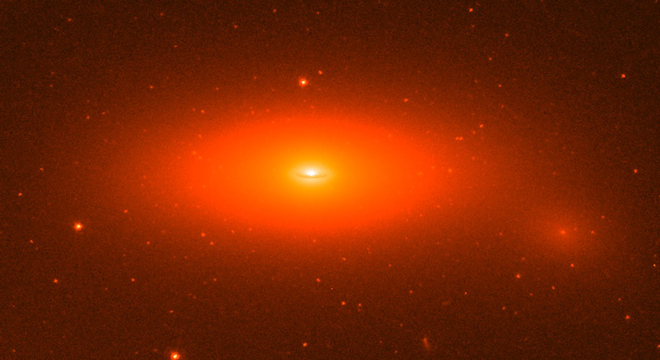Updated 7:16 p.m. EST, Wednesday, November 28
Astronomers using a telescope in the Lone Star state have measured what they believe is the most massive black hole yet recorded, The University of Texas at Austin (UT) announced on Wednesday.
The black hole, which lies at the center of the galaxy NGC 1277, located some 220 million light-years from Earth, is so big it is difficult to comprehend: It is 17 billion solar masses, or 17 billion times the mass of our Sun, and makes up 14 percent of its relatively small host galaxy’s entire mass. The galaxy in question is about 10 percent the size of our Milky Way, for reference.
The black hole is so wide that it would extend well past the orbit of Neptune around our Sun were it transposed to our Solar System — subsuming most of it — as the following illustration from UT indicates:

To put that in another perspective: Although astronomers think most active galaxies, including our own Milky Way, contain supermassive black holes at their centers (black holes that several billion solar masses, or several billion times the mass of our Sun), most of these are on the order of 0.1 percent of the “stellar bulge” — the brightest and densest portion of stars near the galaxy’s center.
By contrast, this galaxy’s black hole makes up 59 percent of its bulge, as the scientists who measured it explain in a paper on their findings, published this week in the journal Nature.
“This is a really oddball galaxy,” said UT astronomer Karl Gebhardt, one of the team of U.S. and German astronomers who measured the black hole, in a UT news release. “It’s almost all black hole. This could be the first object in a new class of galaxy-black hole systems.”
Even by astronomers’ more conservative estimates, the black hole would still be among the largest ever recorded so far. Previously, the galaxy NGCâ4486B was found to have the most massive black hole at 11 percent of its mass. There is another black hole that could be between 6 and 20 solar masses, as well, Gebhardt told TPM in a phone conversation.
Still, it’s the ratio of this black hole’s mass to the mass of the galaxy that has Gebhardt and other astronomers astonished.
“We don’t understand how to make a system like this,” Gebhardt said.
Black hole size is usually constrained after a certain point by the buildup of jets of material — gas and dust — spewing forth from it. As Gebhardt explained, black holes are thought to most typically form after gas and dust collapses into the middle of a galaxy. As the dust and gas interacts, it grows a black hole, but it can’t squeeze all of the nearby material into such a dense space, so it streams jets and winds of the material. As the material flies out, it can block other material from coming in, effectively “choking off” the black hole’s fuel supply and capping the size.
But the newly measured black hole is “100 times off that ratio,” Gebhardt told TPM.
The new record-holding extraordinarily large black hole’s mass was determined by using the Hobby-Eberly Telescope at the McDonald Observatory in Jeff Davis County, Texas — the world’s fourth largest optical telescope, according to UT.
The telescope’s observation of the galaxy found it to be lenticular, or like the Milky Way’s spiral shape but without “arms” of stars extending from it, as well as flat and “disky,” which means that it was most likely oriented with its edge toward the telescope’s view back here on Earth.
Scientists calculated their mass estimate for the black hole using a widely accepted method derived from German astronomy pioneer Karl Schwarzschild, which assumes that black hole has a finite mass. They also compared the imagery of the galaxy taken by the Hobby-Eberly Telescope with previous imagery captured by the Hubble Space Telescope.
Both telescopes were instrumental in the process because the Hobby-Eberly was used to determine the galaxy’s spectra — how fast its stars were moving in their orbits around the galactic center — while Hubble was used to determine where the stars were located within the galactic mass.
Gebhardt said the stars would be moving 10 times faster than in other comparable galaxies due to the immense size of the black hole, and that near the event horizon — the edge of the black hole where nothing can escape its pull — some stars could be ripped apart.
“Stars may have their atmosphere torn apart,” Gebhardt said. “You’d see larger optical flares brighter X-ray flares.”
In the end, after running a computerized model to determine the most likely fit for the black hole’s mass, Gebhardt and his collaborators were left with the result of 17 billion solar masses.
Astronomers have been using the Hobby-Eberly Telescope to conduct a “Massive Galaxy Survey,” focusing in on 700 nearby galaxies with the largest masses, with 100 still left to go. For this particularly huge find, they observed NGCâ1277 and “five other compact galaxies,” all of which could also have “over-massive” black holes on the order of the one detailed in the paper.
Indeed, so while this black hole may take the record for the largest yet uncovered, it may also not stand for long. After all, scientists have only measured the masses of less than 100 black holes so far.
“Those other ones [galaxies] require very massive black holes, too,” Gebhardt said. “I’m kinda jazzed for that.”
Late update: Added direct quotes and information from Gebhardt throughout.
Correction: This article originally incorrectly stated that 17 billion solar masses was 17 times the mass of the Sun, when it fact, it is 17 billion times. We have since corrected the error in copy and regret it.






